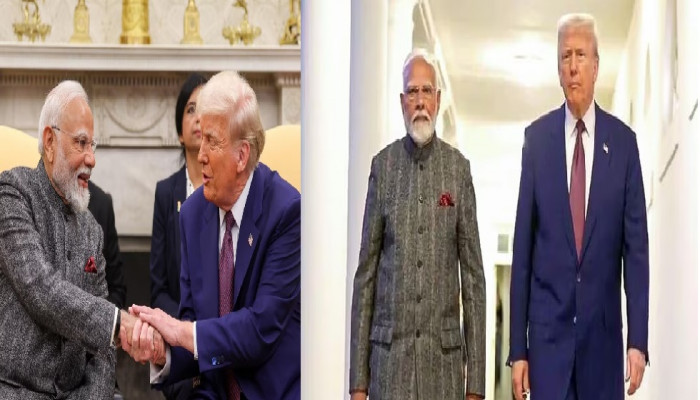Securing National Interests with Win-Win Cooperation
- In Foreign Policy
- 02:37 AM, Feb 16, 2025
- Ramaharitha Pusarla
After dropping a big signal with the ‘privileged’ front-row seat to Indian representative EAM Jaishankar at his inauguration, President Trump extended a direct invitation to PM Modi to the White House. The invite is an indication of the strategic position of India in the hierarchy of Trump’s foreign policy. PM Modi is among the first few leaders to have a bilateral with the 47th President within the first three weeks of his tenure.
India’s relationship with the United States has been cagey, plagued by hesitations of history. The bilateral ties which registered a marked upswing since the turn of the century have swiftly matured into a Comprehensive Global Strategic Partnership with an expansive multi-sectoral cooperation ever since.
Strong leaders are known to steer a less chartered course, which is also characterised by disruption and uncertainty. Trump’s radical decisions and a blizzard of executive orders reflected an urgency to overhaul policy frameworks and infuse fresh energy. The string of bilateral meetings with heads of different countries in quick succession is an extension of a similar exercise.
Unlike the bluster of the first term which fizzled out and lacked the meat an alloyed Trump 2.0 objectively clear about geopolitical and strategic priorities, hit the ground running from day one with a sharp diplomatic agenda. India has been quick to grasp this and instead of getting frazzled, New Delhi made necessary tweaks and amends in policies to deal with a hard-nosed Trump.
Personal diplomacy has been Trump’s forte who seeks to form personal bonds with leaders. PM Modi who enjoys an excellent rapport with Trump travelled to Washington on February 13th for a working official visit to infuse fresh momentum in the India-US relationship. PM Modi was hosted at the Blair House, the Presidential Guest House usually reserved for leaders of strategic allies signalling Trump’s priority to the India-US relationship.
Hours before the scheduled bilateral meeting, Trump announced sweeping reciprocal tariffs. Trump in the past called India a “tariff king” and with the inevitable tariff threat looming large, Modi engaged in four-hour restricted talks with Trump. Tariffs are a negotiation tool Trump wielded against India which enjoys a trade surplus with the US.
In anticipation of the inevitably reciprocal tariff regimen, the finance minister announced cuts in Basic Customs Duty (BCD) on important products in the budget. Appreciating these efforts, in ‘good faith’, Trump agreed to trek the Bilateral Trade Agreement (BTA) trade route which was abruptly disbanded in 2020. Learning from the Covid experience seeking to diversify trade and deepen the integration of supply chains, countries set a target of $500 billion in bilateral trade-Mission 500.
To reduce the trade surplus, Trump pressed India to increase military purchases. To lure India, Trump offered fifth-generation F35 stealth fighters and undersea systems. F35s are reserved for America’s most trusted allies and NATO partners. Rebuking Trump for a potential F35 transfer to India, Beijing shot back, “Asia-Pacific is a stellar example of peace, not an era of geopolitical games”. The decision even unsettled Pakistan.
Guided by national interests, leaders mooted co-production “Javelin” Anti-Tank Guided Missiles and “Stryker” Infantry Combat Vehicles with manufacturing units in both countries. This effectively dovetails with India’s Make in India policy as well. Countries announced plans to sign an open-ended ten-year “Framework for India-US Major Defence Partnership in the 21st century” and decided to commence negotiations on the Reciprocal Defence Procurement (RDP) arrangement for reciprocal supply of defence goods and services.
In his first telephonic conversation with PM Modi, Trump pushed New Delhi to increase energy purchases to ease the trade deficit. Reviving the U.S.-India Energy Security Partnership, Trump pledged to become India’s reliable energy partner. To make it a win-win proportion, India plans to divert these imports to boost its strategic oil reserves as a buffer against future exigencies.
Energy security is the bedrock of economic development. To put the economy on full throttle, India intends to harness all sources of energy. To realise the India-US 123 Civil Nuclear Agreement, India made tweaks to the Atomic Energy Act and Civil Liability for Nuclear Damage Act (CLNDA) that hindered the nuclear collaboration ahead of the visit. With this, India put the civil nuclear cooperation option back on the table opening the floodgates for India-US collaboration in building small modular reactors for power generation.
Multi-sectoral cooperation is the cornerstone of the India-US partnership. To make a result-driven and transformative initiative leaders inaugurated- “US-India COMPACT (Catalysing Opportunities for Military Partnership, Accelerated Commerce &Trade) for the 21st Century”. To catalyse collaboration between governments, academia and the private sector, countries launched- TRUST, i.e. Transforming Relationship Utilising Strategic Technology to put on course the US-India Roadmap on Accelerating AI Infrastructure, promote collaboration in critical & emerging technologies and create strong supply chains of critical minerals, advanced materials and pharmaceuticals.
Convergence of strategic interests and Trump’s strong pivot to Asia by reviving the Quad has brought India and the US together and insulated the partnership from flashpoints. Rising geopolitical tensions in the Indo-Pacific and its impact on regional stability forced the US to seek a reliable partner. India’s role as the security provider of the Indian Ocean Region (IOR) and first responder in the Indo-Pacific made it an important player in the US’s Indo-Pacific region security architecture.
Britain’s ceding of the Chagos archipelago, home to the US’s military base Diego Garcia to Mauritius had fuelled fears of boosting Chinese interests. To counter Chinese influence, leaders launched the Indian Ocean Strategic Venture Forum to promote investments for boosting economic connectivity and commerce.
India is also a valuable partner for the US in its Middle East policy. Trump expedited the ceasefire agreement between Israel and Hamas and prioritised trade & peace in the Middle East to renew the IMEC (India Middle East Europe Connectivity). The progress of IMEC was halted after October 7 Hamas terror attack. India has a pivotal role in IMEC and is an important player in America’s geopolitical scheme of things.
India and the US have a zero-tolerance approach towards terrorism. Reiterating their position, Modi and Trump condemned the global scourge of terrorism, especially that emanating from the Al-Qa’ida, ISIS, Jaish-e Mohammad, and Lashkar-e-Tayyiba in the region. Trump even “called on Pakistan to expeditiously bring to justice the perpetrators of the 26/11 Mumbai, and Pathankot attacks and ensure that its territory is not used to carry out cross-border terrorist attacks”. By calling out Pakistan’s state-sponsored terrorism, Trump has unequivocally de-hyphenated India and Pakistan and irrevocably undermined its international stature. In fact, the extradition of Tahawwur Rana, Trump is a major diplomatic victory for India.
Unlike the Biden administration which doubled economic aid, approved $450 million towards the F-16 fighter jet fleet sustainment program and favoured World Bank loans to Pakistan, the Trump administration has been forthright about Islamabad’s terrorism credentials.
Since his inauguration, Trump has cracked the whip on countries for two aspects- tariffs and illegal migration. India found itself at the receiving end after a US military plane carrying illegal Indian migrants landed in Amritsar. To address this issue, leaders agreed to crack down the illegal immigration networks and organised crime syndicates.
Making a distinction between illegal and legal migration and valuing the benefits of talent flow, the countries vowed to put in place “mutually advantageous and secure mobility frameworks” to facilitate legal migration. The joint statement carried a stern message to Khalistanis- “elements that threaten public and diplomatic safety and security, and the sovereignty and territorial integrity of both nations” too.
Trump's war on USAID opened a Pandora’s Box and threw open the dark secrets and vicious agenda that threatened to dismantle the stable political apparatus of several nations including India. Responding to a query on “regime change” in Bangladesh Trump dismissed the role of the Deep State. However, acknowledging the enormity of instability stirred in the Indian neighbourhood, Trump understandably remarked, “I will leave Bangladesh to the PM”.
Biden administration’s covert alignment with elements mainstreaming anti-Indian propaganda coupled with an umbrella of protection to separatist elements has eroded the trust and mutual respect of the partnership. Relentless attempts to tarnish India’s image have seeded scepticism towards the US administration. The democratic coup in Bangladesh was the last straw. Under Biden India-US ties touched their nadir.
Trump’s unconventional approach perturbs both allies and enemies alike. However, Modi’s effortless flexibility and diplomatic nimbleness to quickly navigate through the liminal layers of the American polity irrespective of political leadership at the helm has put India in good stead. The genuine urgency demonstrated by Trump to regain India’s trust notwithstanding his transactionalism has added an element of pragmatism to the India-US relationship.
Resonating with the US’s MAGA, ingenuously coining MIGA -Make India Great Again and calling for a MEGA partnership- MAGA plus MIGA, Modi in all earnest reciprocated Trump’s overtures. Aligning Trump’s MAGA with India’s Viksit Bharat 2047, Trump and Modi avowed nationalists, prioritising national interests have endeavoured to chart out a blueprint for the future of the India-US partnership.
References
- https://www.mea.gov.in/Speeches-Statements.htm?dtl/39067/English_translation_of_Press_Statement_by_Prime_Minister_Shri_Narendra_Modi_during_the_India__USA_Joint_Press_Conference_February_13_2025
- https://www.mea.gov.in/bilateral-documents.htm?dtl/39066/India__US_Joint_Statement_February_13_2025
- https://www.mea.gov.in/media-briefings.htm?dtl/39068/Transcript_of_Special_briefing_by_MEA_on_Prime_Ministers_visit_to_USA_February_13_2025
Disclaimer: The opinions expressed within this article are the personal opinions of the author. MyIndMakers is not responsible for the accuracy, completeness, suitability, or validity of any information on this article. All information is provided on an as-is basis. The information, facts or opinions appearing in the article do not reflect the views of MyindMakers and it does not assume any responsibility or liability for the same.







Comments